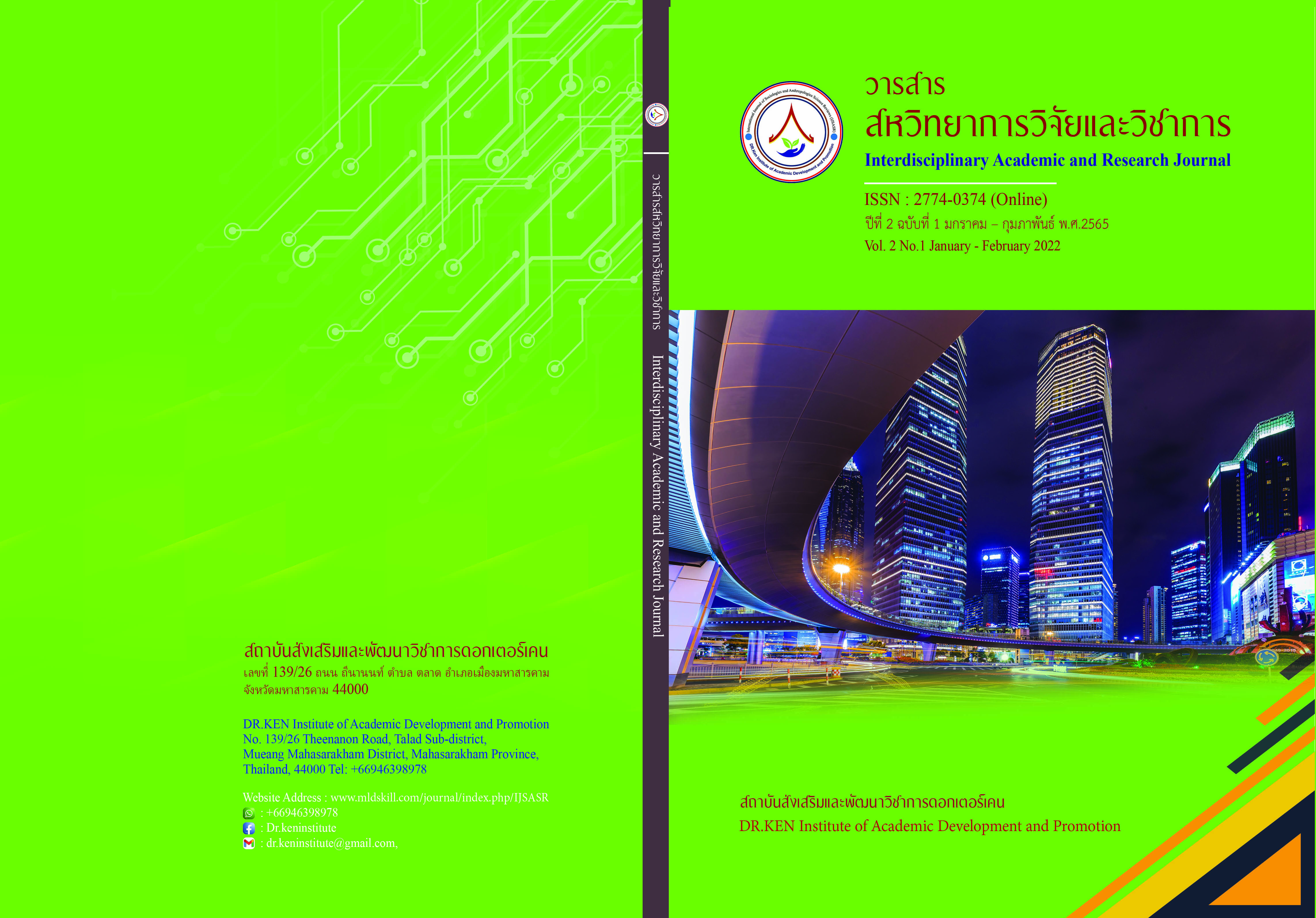Performance Motivation that affecting the Employee Engagement
DOI:
https://doi.org/10.14456/iarj.2022.4Keywords:
Motivation, Motivation factors, Hygiene Factors, CommitmentAbstract
Management is an important aspect of every organization; human resource is the most important factor in creating jobs to progress. Performance satisfaction is a key factor in how a person feels good about their job, as well as being a motivator that helps a person to be willing to perform to the best of their ability, resulting in effective performance. Work according to the set goals. If the personnel is motivated to work, then they are happy and satisfied with the work they perform and incentivize loyalty to the organization, until it becomes a bond. Therefore, this article is a review of the literature and research related to performance motivation affecting employee engagement, which will be useful to those interested in applying it as a guideline for organizational adoption. The results of the analysis revealed that: Performance motivation factors consist of motivation factors, and supporting factors, the motivation factors are, success in performance, recognition, advancement, nature of work, responsibility. And supporting factors include organizational policies and administration, command, relations between colleagues, supervisors, salary/wages, and general conditions. Employee engagement consists of a sense of belonging to the organization, acceptance of the organization's management policy goals, dedication to the organization's performance efforts, concern for the future of the organization, and the desire to maintain membership of the organization.
References
กุลนันท์ โป๊ะเงิน. (2562). ความสัมพันธ์ระหว่างแรงจูงใจในการปฏิบัติงานกับความผูกพันต่อองค์กรของพนักงาน บริษัทมาสด้า ซิตี้. การประชุมนำเสนอผลงานวิจัยบัณฑิตศึกษาระดับชาติ ครั้งที่ 14 (หน้า 756-765). กรุงเทพฯ: บัณฑิตวิทยาลัย มหาวิทยาลัยหอการค้าไทย.
จุรี วรรณาเจริญกุล. (2563). ปัจจัยที่มีผลต่อแรงจูงใจในการปฏิบัติงานของข้าราชการสำนักงานการตรวจเงินแผ่นดิน. วารสารรัฐศาสตร์ มหาวิทยาลัยราชภัฏสวนสุนันทา, 3 (2), 125-138.
จุลดาลัด ฉวีสุข. (2559). การศึกษาทัศนคติของพนักงานเทคโนโลยีสารสนเทศต่อความผูกพันขององค์กรบริษัทการให้บริการงานรับจ้างเหมาทางเทคโนโลยีสารสนเทศ (IT Outsourcing) แห่งหนึ่งในเขตกรุงเทพมหานคร (สารนิพนธ์ ปริญญาการจัดการมหาบัณฑิต วิทยาลัยการจัดการ). มหาวิทยาลัยมหิดล, กรุงเทพฯ.
ชนาวิทย์ พรชูตรง. (2559). การศึกษาปัจจัยส่วนบุคคล วัฒนธรรมองค์การ แรงจูงใจในการปฏิบัติงานและสภาพแวดล้อมในการทำงาน ที่มีอิทธิพลต่อความผูกพันภายในองค์การของ พนักงานระดับปฏิบัติการในเขต สาทร บางรัก วัฒนา คลองเตย. การค้นคว้าอิสระ บริหารธุรกิจมหาบัณฑิต: มหาวิทยาลัยกรุงเทพ.
ฐิติพร เสถียรพันธุ์ และพนิตา สุรชัยกุลวัฒนา. (2561). แรงจูงใจที่มีผลต่อความพึงพอใจในการปฏิบัติงานของพนักงาน บริษัท ไทยเคียววะไบโอเทคโนโลยีส์ จำกัด. การประชุมนำเสนอผลงานวิจัยระดับบัณฑิตศึกษา ครั้งที่ 13 (หน้า 82-89). ปทุมธานี: บัณฑิตวิทยาลัย มหาวิทยาลัยรังสิต.
ณัฏฐ์พัชร์ ลาภบำรุงวงศ์. (2562). การประยุกต์ทฤษฎีแรงจูงใจในการปฏิบัติงาน. วารสารวไลยอลงกรณ์ปริทัศน์ (มนุษยศาสตร์และสังคมศาสตร์), 9 (2), 161-171.
ทองฟู ศิริวงศ์. (2555). พฤติกรรมองค์การ. (พิมพ์ครั้งที่ 3). มหาวิทยาลัยเกษตรศาสตร์ คณะบริหารธุรกิจ ภาควิชาการจัดการ.
ธิตานันท์ พงศ์ละไม. (2560). คุณภาพชีวิตในการทำงาน กับความผูกพันของพนักงานของบริษัท เบรนน์แท็ก (ประเทศไทย) จำกัด. สารนิพนธ์การจัดการมหาบัณฑิต วิทยาลัยการจัดการ: มหาวิทยาลัยมหิดล.
พัชญา แสงประสิทธิ์ และจันทนา แสนสุข. (2560). แรงจูงใจในการปฏิบัติงานและประสิทธิภาพในการปฏิบัติงานของบุคลากร กรมตรวจบัญชีสหกรณ์ในเขตพื้นที่ สำนักงานตรวจบัญชีสหกรณ์ที่ 1. วารสารการเมือง การบริหาร และกฎหมาย, 9 (1), 189-209.
พัชร์หทัย จารุทวีผลนุกูล, ธัญวฤณ วัทโล, และวิลาสิณี สุดประเสริฐ. (2563). ปัจจัยที่ส่งผลต่อความผูกพันต่อองค์การของพนักงาน บริษัท เอสเอสเค โลจิสติกส์ จํากัด. วารสารวิชาการสังคมศาสตร์เครือข่ายวิจัยประชาชื่น, 2 (3), 27-39.
วรเชษ บุญประกอบ. (2559). ความสัมพันธ์ระหว่างแรงจูงใจในการปฏิบัติงานกับความผกูพันต่อองค์กร ของ ครูในสถานศึกษาสังกัดสำนักงานส่งเสริมการศึกษานอกระบบและการศึกษาตามอัธยาศัยจังหวัดกระบี่. วารสารวิชาการมหาวิทยาลัยราชภัฏภูเก็ต, 12 (1), 82-102.
สมศักดิ์ สงวนดี. (2563). ปัจจัยที่มีผลต่อความพึงพอใจในการปฏิบัติงาน. วารสารชัยภูมิปริทรรศน์, 3 (2), 34-39.
อนุดิษฐ์ ฐานไชยกร. (2562). ความผูกพันในองค์การ. Journal of Roi Kaensarn Academic, 4 (1), 32-46.
Becker, H.S. (1960). Notes on the Concept of Commitment. American Journal of Sociology, 66, 32-42.
Buchanan, H. B. (1974). building organization commitment, the socialization of managers in work organization. Administrative Science Quarterly, 19, pp.
David L. Loudon & Albert J. Della Bitta . (1998). Consumer Behavior: Concepts and Applications. New York: McGraw-Hill.
Kahn, W. A. (1990). Psychological conditions of personal engagement and disengagement at work. Academy of Management Journal, 33(4), 692–724.
Mowday, R.T., Porter, L.W. and Steers, R.M. (1982). Employee-Organization Linkages: The Psychology of Commitment, Absenteeism, and Turnover. Academic Press, New York.
Porter, L. and Smith, F.J. (1970). The Etiology of Organizational Commitment. Unpublished Manuscript, University of California,
Steers, R. M. (1977). Antecedents and outcomes of organizational commitment. Administrative Science Quarterly. 22, 46-56.
Steers, R.M., and Porter, L.W. (1983). Motivation and Work Behavior. New York. McGraw-Hill.
Theresa M. Welbourne. (2014). The “Wildfire” That Is Employee Engagement. Incentive Research Foundation [Online] https://eepulse.com/files/2018/03/Engaged-In-What.compressed.pdf]
Walters. (1978). Adaptive Management of Renewable Resources. New York: Mc Graw - Hill.
Downloads
Published
How to Cite
Issue
Section
License
Copyright (c) 2022 Interdisciplinary Academic and Research Journal ISSN 2774-0373 (Online)

This work is licensed under a Creative Commons Attribution-NonCommercial-NoDerivatives 4.0 International License.
Copyright on any article in the Interdisciplinary Academic and Research Journal is retained by the author(s) under the under the Creative Commons Attribution-NonCommercial-NoDerivatives 4.0 International License. Permission to use text, content, images, etc. of publication. Any user to read, download, copy, distribute, print, search, or link to the full texts of articles, crawl them for indexing, pass them as data to software, or use them for any other lawful purpose. But do not use it for commercial use or with the intent to benefit any business.
















.png)


